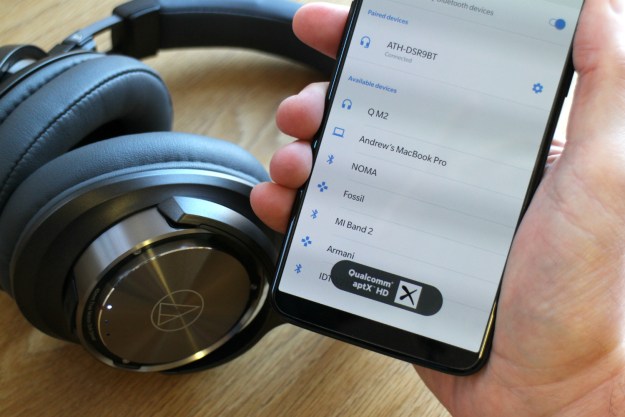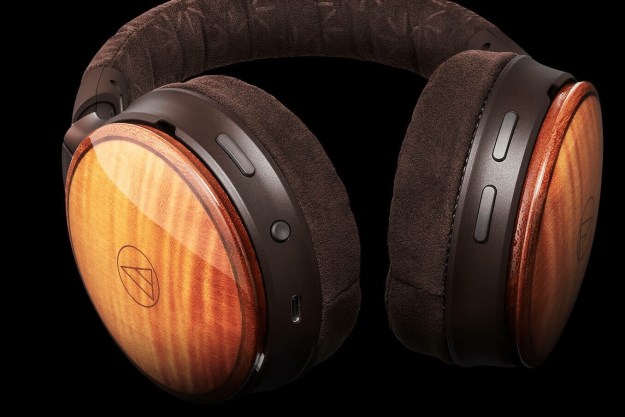- Comfortable
- well-designed ear pads; excellent noise cancellation; will play music passively; easy storage; powerful
- well-balanced sound
- Slightly large ear-cup size; slight emphasis on mid-bass
Summary
Audio Technica has been setting the standard in studio quality headphones since it first released the AT-700 in 1974. With the introduction of the ATH-ANC7b QuietPoint Noise-Cancelling headphones, Audio Technica has once again raised the bar for the competition. Priced at $219.99, these cans perform better, feel more comfortable and offer more features and functions than headphones costing much more. Whether you fly often, need some “space” at the office or just enjoy high-fidelity music, these headphones will offer a quiet retreat from the din around you, and immerse you in incredible sound.
Out of the Box
The QuietPoint headphones come packed in a reinforced black canvas zipper case. Opening the case reveals the headphones seated neatly atop molded pieces to help hold them in place and ease re-packing. Inside the front cover is a small mesh pouch that holds a 1/8” to ¼” adapter, an airline adapter, and a longer, 5.2-foot cable. The gold plating on the accessories is a nice touch, and hints at other thoughtful features we’ll note later on. The included 3.3-foot, detachable 
Features and Design
We were immediately impressed with the quality of material in the ear padding. What feels like memory foam is luxuriously covered in supple, black leather. Deeper into the earpiece, the 40mm driver is covered in black cloth, not the cheaper black foam found on lesser quality headphones. The ATH-ANC7b’s outer housing and headband is made of durable, impact-resistant plastic and is easily adjusted. The headband also offers a very comfortable pad on top, something important for

Unlike many other collapsible headphones that require Rubik’s-cube-like twisting and repositioning of the headset, packing these away is a snap. The left and right earphones rotate inward, and the raised supports in the case are a clear indication of what goes where. It’s a simple design that works extremely well.
One of the pleasantly surprising features here is that this set of headphones work passively. With many other sets of noise-cancelling
Performance
As soon as we put on the ATH-ANC7b’s, we noticed an immediate decrease in ambient noise. The soft, self-molding padding did an impressive job of sealing around the ear. In fact, the seal was so good that we got the impression our ears were in their own little atmosphere. When pressed against our head, pressure against the eardrum could be felt that reminded us a little of the pressure changes you experience when going up and down steep hills. It took some getting used to, but once acclimated, we hardly noticed the effect.

Next, we tested the ‘phones with the ubiquitous iPod. Here, we used a mix of both compressed and uncompressed music. With compressed music, the low quality was more exposed. The raspy sibilance of the treble was more distinct than with low quality earbuds; but that is to be expected. The sound quality on the uncompressed music more than made up for it, though. Top to bottom, the QuietPoint headphones exuded authority and finesse. Highs were smooth – never shrill. The midrange was open and natural, and the bass, if just a bit heavy, was tight and tonally on point. While a little bit of EQ adjustment helped in the bass department, we didn’t have to wrangle these

As we changed from receiver to laptop and, finally, a headphone amp, we noticed that the ATH-ANC7b’s sonic character changed with its source. As the source improved or changed, so did the sound. We enjoyed a huge amount of detail and separation with the ATH-ANC7b on all of the components it was tested with, and consider the soundstage depth and transparency to be on par with many audiophile solutions. Certainly, we would recommend this as an audiophile grade product for avid listeners who are frequently on-the-go.
Conclusion
True audiophile quality sound and effective noise cancelling don’t usually come in the same box, but Audio-Technica managed to do it here, and kick in some extremely thoughtful features and functionality as well. With a $200 street price, you’re still going to have to shell out a few bucks, but the return on investment is very high. Those considering noise cancelling headphones need to give the ATH-ANC7b a serious test drive. We think you’ll be pleasantly surprised.
Pros:
- Comfortable, well-designed ear pads
- Excellent noise cancellation
- Will play music passively (no battery)
- Easy storage
- Powerful, well-balanced sound
Cons:
- Slightly large ear-cup size
- Slight emphasis on mid-bass
Editors' Recommendations
- Samsung adding Auracast and 360 Audio to more TVs, phones, and earbuds
- Apple has upgraded the AirPods Pro with lossless audio, sort of
- Sony updates WH-1000XM5 with head-tracked spatial audio and better multipoint
- Can we talk about wireless audio’s missing speedometer?
- CES 2023: Audio-Technica adds a mic to its iconic M50x headphones to target creators





